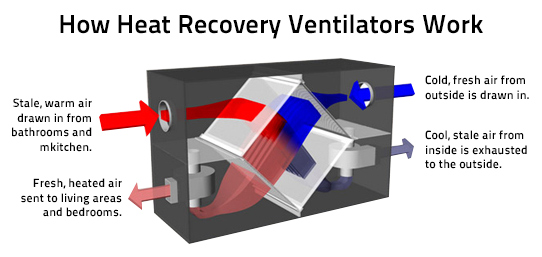The All-Inclusive Overview to the Uses of Heat Recovery Ventilation in Modern Buildings
Heat Recovery Ventilation (HRV) systems stand for a considerable advancement in constructing innovation (HRV Heat Recovery Ventilation). They provide a technique for exchanging stagnant indoor air with fresh exterior air while reducing power loss. This strategy not only boosts indoor air high quality but likewise adds to energy effectiveness in both residential and industrial structures. Comprehending the numerous applications and advantages of HRV can expose its vital role in modern layout and sustainability initiatives. The implications of this modern technology are worth checking out further
Comprehending Heat Recovery Ventilation Solutions

Numerous modern buildings prioritize energy effectiveness, comprehending heat healing air flow (HRV) systems is essential for enhancing indoor air top quality and decreasing energy intake. HRV systems function by moving heat from stagnant interior air to inbound fresh air, successfully keeping comfortable interior temperature levels while minimizing energy loss. These systems are composed of a warmth exchanger, followers, and ductwork that assist in the flow of air. During winter season, HRV systems catch and reuse warm from the outgoing air, while in summer, they can help cool incoming air. By constantly exchanging air, HRV systems also reduce humidity and the focus of interior contaminants. Appropriate installation and maintenance of HRV systems are vital for their efficiency and effectiveness in enhancing total structure performance and comfort.
Advantages of Heat Recovery Ventilation
Heat recovery ventilation systems supply many benefits that boost both power effectiveness and interior air high quality in modern structures. By catching and reusing power from exhaust air, these systems greatly lower home heating and cooling costs, bring about reduced energy intake. Moreover, they maintain a constant circulation of fresh outdoor air, minimizing the threat of indoor air toxins and irritants. This continuous exchange aids regulate moisture levels, protecting against mold and mildew growth and making certain a much healthier living atmosphere. Additionally, HRV systems add to sustainability goals by lowering overall carbon impacts. Their capacity to enhance ventilation without giving up thermal convenience makes them a valuable enhancement to contemporary structure layout, promoting both economic and eco-friendly benefits.
Applications of HRV in Residential Buildings
As homeowners increasingly prioritize power effectiveness and interior air top quality, the applications of heat recovery ventilation (HRV) systems in property buildings have actually come to be much more common. HRV systems are especially advantageous in firmly secured homes, where preserving fresh air flow is essential for avoiding dampness accumulation and indoor contaminants. They effectively transfer warmth from outward bound stagnant air to inbound fresh air, reducing power expenses linked with heating & cooling. Additionally, HRVs can improve comfort levels by controling humidity and temperature level. They are also versatile for different domestic designs, including single-family homes and multi-unit structures. On the whole, incorporating HRV systems sustains lasting living practices while ensuring a healthier interior environment for owners.
HRV in Business and Industrial Settings
In business and commercial settings, the implementation of warmth recovery air flow (HRV) systems has actually come to be significantly essential for enhancing power performance and maintaining air quality. These systems efficiently transfer warm from exhaust air to inbound fresh air, minimizing the requirement for extra heating or air conditioning. This not just reduces energy prices however likewise adds to sustainability initiatives. Industries such as production, warehousing, and office complex benefit substantially from HRV systems, as blog here they aid control temperature and moisture degrees, guaranteeing a comfy and productive setting. Moreover, HRV systems aid in getting rid of pollutants and excess moisture, improving indoor air top quality. As regulations around air top quality become more stringent, the adoption of HRV technology is likely to expand, making it a crucial component of modern business and industrial facilities.
Future Fads in Heat Recovery Ventilation Innovation

Often Asked Inquiries
Just How Does Heat Recovery Ventilation Influence Indoor Air Quality?
Heat recovery ventilation significantly improves interior air top quality by continually exchanging stale indoor air with fresh outdoor air while recouping power. This procedure minimizes contaminants, maintains perfect humidity degrees, and assures a much healthier setting for passengers.
Can HRV Solutions Be Installed in Existing Structures?
HRV systems can without a doubt be mounted in existing buildings. Retrofitting may call for alterations to ductwork and ventilation layouts, however it considerably enhances power performance and interior air high quality, making it a practical choice for older structures.
What Upkeep Is Required for HRV Systems?

Are There Specific Climates Where HRV Is More Effective?
Heat recovery ventilation systems are particularly reliable in environments with substantial temperature level distinctions between seasons. These systems optimize power performance by recovering heat from exhaust air, making them optimal for both cool and reasonably cozy atmospheres.
Exactly How Do HRV Systems Affect Energy Expenses?
